This article needs additional citations for verification .(April 2021) |

The Ohio Railway Museum [1] ( reporting mark ORMX) [2] is a railway museum that was founded in 1948. It is located in Worthington, Ohio, near Columbus, Ohio.
This article needs additional citations for verification .(April 2021) |

The Ohio Railway Museum [1] ( reporting mark ORMX) [2] is a railway museum that was founded in 1948. It is located in Worthington, Ohio, near Columbus, Ohio.

Established in 1948 and incorporated August 22, 1950, it is one of the oldest organization involved with the preservation of railroad equipment and railroad history in North America that includes an operating railroad line. The museum was started on the grounds of the former Columbus, Delaware and Marion Railway with the name of "The Central Ohio Railfans Association" and officially changed its name to The Ohio Railway Museum February 17, 1993.
The Ohio Railway Museum (ORM) is an educational organization dedicated to the preservation and operation of historic railway equipment. A special focus is its collection of historic Ohio Railway equipment and artifacts. The museum educates the public through operations of historic equipment; special events; publications; and community involvement.
Car #21 was the first piece acquired by the museum in 1947. It was moved to the museum grounds in 1948. The car is a fine example of wooden interurban car construction as of the 1900-1910 period. It was built by the Niles Car and Manufacturing Company of Niles, Ohio in 1905. It is considered a combination passenger-baggage type interurban. The car is 50 feet 6 inches (15.39 m) long and weighs 60,500 pounds. It is equipped with four General Electric number 263A 65 hp (48 kW) motors, one General Electric type K-34D2 controller and one Westinghouse 3817 air compressor. Car #21 and its sister #20 both had a baggage compartment at the front, a smoker section seating 12, and a main passenger section seating 34. The car is single-ended and is operated from the baggage compartment. Also inside the baggage compartment is an early telephone that could be used for communications with the dispatcher by hooking the leads over a phone line strung along the track. The interior of the car is finished in quartered oak, originally with leather seats in the smoking compartment and plush seats in the passenger section. The car is listed on the National Register of Historic Places.
Norfolk and Western 578 is a 4-6-2 "Pacific" E2a steam locomotive built in March 1910 by the American Locomotive Company's Richmond Works. The full length including the tender is 90 feet 9 inches (27.66 m). The weight fully loaded is 285 tons (259 t). The 6 sets of wheels from front to back are two sets of 33-inch (840 mm) wheels for the pilot truck, 3 sets of 70-inch (1.8 m) wheels for the drivers, and one set of 42-inch (1,100 mm) wheels for the trailing truck. The tender has 2 Buckeye steel built 6 wheel trucks each wheel at 33 inches. The full height of the locomotive is 15 feet 9 inches (4.80 m) The fuel capacity is 26 tons of coal and 18,000 U.S. gallons (68,000 L) of water. This locomotive was donated to the Ohio Railway Museum on February 12, 1959, from the Norfolk and Western Railway Company.
Norfolk & Western #578 is the last surviving one of 26 E2a locomotives built for the Norfolk and Western Railway Company. Numbers 553-558 were built by the Baldwin Locomotive Works while numbers 559-563 were built by the Norfolk & Western shops at Roanoke and numbers 564-579 were built by Alco's Richmond Works.
The 4-6-2 designation indicates that there are four wheels in the pilot truck, six driving wheels, and two wheels in the trailing truck. The term "Pacific" was given to this wheel arrangement because it was first used on the Missouri Pacific Railroad. The E2a locomotives were first used for mainline passenger service and later for branch line service when replaced by larger equipment. The E2a's could pull up to 8 heavy Pullman passenger cars at 70 miles per hour. Through the years, these locomotives were equipped with various types of tenders. The current tender on #578 is the largest used with any E2a and is originally from a larger 4-8-2 "Mountain" type locomotive. It is equipped with a stoker and can be operated with an auxiliary tender for greater range. #578 was assigned to the Scioto division operating into Columbus from 1917 to 1944, and was transferred to the Norton branch from Bluefield, West Virginia to Norton, Virginia, and was retired from service in December 1958 after a 48-year career.
This 0-4-0 saddle tank steam locomotive was built in 1924 by the Vulcan Iron Works. It is 20 feet (6.1 m) long (6 m) and weighs 40,000 pounds (18,000 kg) and has 4 drivers, each measuring 33 inches (840 mm) in length. It was donated to the museum in 1954 in operating condition after service with the Marble Cliff Quarries Company. It was used by the museum to pull N&W #578 onto the museum property.
In 2006, the engine was cosmetically restored and Loaned to The Depot Rail Museum. [3] In 2018 #1 was moved back to the museum property and is on display again.
472 is a 4-wheel DuPont Type C single-truck streetcar built in 1900 by the Brownell Car Company. It is 30 feet (9.1 m) long and seats 24 passengers with a crew of 2. It was donated to the museum in 1956.
703 is a Columbus streetcar built in 1925 by the G. C. Kuhlman Car Company. It weighs 36,620 pounds (16,610 kg) and is 45 feet 3.3 inches (13.800 m) long. It seats 48 passengers and 2 crew members. It currently has Canadian Car & Foundry 3550 type trucks with 26 inch diameter wheels. It was donated to the museum in 1962. Street Car 703 is currently[ when? ] under restoration to working order.
450 is a Presidents' Conference Committee (PCC) car. Built in 1949 by the St. Louis Car Company, it is 50 feet 5 inches (15.37 m) long and weighs 42,680 pounds (19,360 kg). It was donated to the museum in 1964. It runs trips taking visitors up and down the line on the museum's operating days.

A 2-8-8-4 steam locomotive, under the Whyte notation, has two leading wheels, two sets of eight driving wheels, and a four-wheel trailing truck. The type was generally named the Yellowstone, a name given it by the first owner, the Northern Pacific Railway, whose lines ran near Yellowstone National Park. Seventy-two Yellowstone-type locomotives were built for four U.S. railroads.

Under the Whyte notation for the classification of steam locomotives, 4-8-4 represents the wheel arrangement of four leading wheels on two axles, eight powered and coupled driving wheels on four axles and four trailing wheels on two axles. The type was first used by the Northern Pacific Railway, and initially named the Northern Pacific, but railfans and railroad employees have shortened the name since its introduction. It is most-commonly known as a Northern.

The Norfolk and Western Railway, commonly called the N&W, was a US class I railroad, formed by more than 200 railroad mergers between 1838 and 1982. It was headquartered in Roanoke, Virginia, for most of its existence. Its motto was "Precision Transportation"; it had a variety of nicknames, including "King Coal" and "British Railway of America". In 1986, N&W merged with Southern Railway to form today's Norfolk Southern Railway.
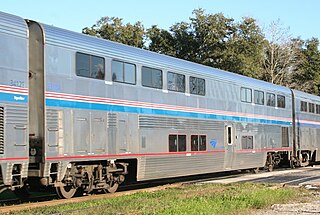
A passenger railroad car or passenger car, also called a passenger carriage, passenger coach, or passenger bogie is a railroad car that is designed to carry passengers. The term passenger car can also be associated with a sleeping car, a baggage car, a dining car, railway post office and prisoner transport cars.
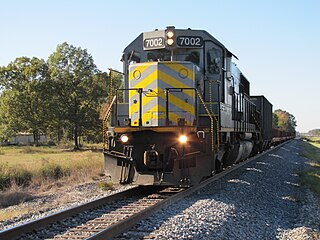
The EMD SD50 is a 3,500-horsepower (2,610 kW) diesel-electric locomotive built by General Motors Electro-Motive Division. It was introduced in May 1981 as part of EMD's "50 Series"; production ceased in January 1986. The SD50 was a transitional model between EMD's Dash 2 series which was produced throughout the 1970s and the microprocessor-equipped SD60 and SD70 locomotives. A total of 431 were built.

The 2-6-6-6 is an articulated locomotive type with two leading wheels, two sets of six driving wheels and six trailing wheels. Only two classes of the 2-6-6-6 type were built. One was the "Allegheny" class, built by the Lima Locomotive Works. The name comes from the locomotive's first service with the Chesapeake and Ohio Railway beginning in 1941, where it was used to haul loaded coal trains over the Allegheny Mountains. The other was the "Blue Ridge" class for the Virginian Railway. These were some of the most powerful reciprocating steam locomotives ever built, at 7,500 hp, and one of the heaviest at 386 tons for the locomotive itself plus 215 tons for the loaded tender.

The Market Street Railway Company was a commercial streetcar and bus operator in San Francisco. The company was named after the famous Market Street of that city, which formed the core of its transportation network. Over the years, the company was also known as the Market Street Railroad Company, the Market Street Cable Railway Company and the United Railroads of San Francisco. Once the largest transit operator in the city, the company folded in 1944 and its assets and services were acquired by the city-owned San Francisco Municipal Railway. Many of the former routes continue to exist into the 2020s, but served by buses.
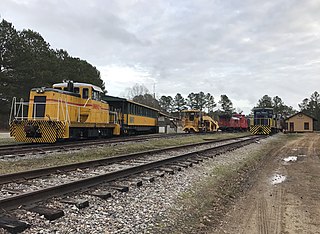
The New Hope Valley Railway is a heritage railroad in Bonsal, North Carolina operated by the North Carolina Railway Museum, Inc., an all-volunteer, nonprofit, and tax exempt educational and historical organization.

The Virginia Museum of Transportation (VMT) is a museum in Downtown Roanoke, Virginia, that is devoted to the topic of transportation.
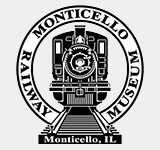
The Monticello Railway Museum is a non-profit railroad museum located in Monticello, Illinois, about 18 miles west of Champaign, IL. It is home to over 100 pieces of railroad equipment, including several restored diesel locomotives and cars.
The Galena and Southern Wisconsin Railroad Company (G&SWRR) existed as a functioning 3 ft narrow gauge railroad from 1874 to 1880, when it was ultimately bought by the Chicago and North Western Railway (C&NW) after a series of short ownership and name changes. Originally it had connections between Galena, Illinois and Platteville, Wisconsin, with later additions reaching up to Monfort Junction, Wisconsin, near Montfort, Wisconsin, where it ran west to Fennimore, WI, and connected to the Chicago and Tomah Railroad.
The Steam Railroading Institute is located at 405 South Washington Street, Owosso, Michigan. It was founded in 1969 as the Michigan State University (MSU) Railroad Club. It became the Michigan State Trust for Railway Preservation, and later adopted its present name.
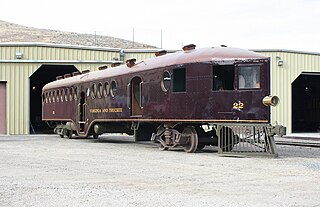
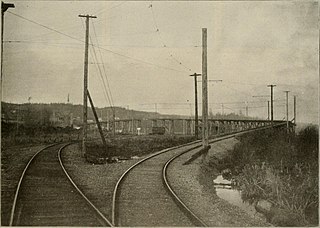
The Everett–Snohomish Interurban was a 9 miles (14 km) long interurban electric railroad between Everett and Snohomish, Washington. It was inaugurated by the Everett Railway & Electric Co. of Everett, on December 1, 1903.

The Miniature Railway Company on Broadway in Manhattan, New York, operated their ridable miniature railways at four World Expositions around 1900 and delivered them to many parks throughout the world.

Atlantic Coast Line 1504 is a 4-6-2 steam locomotive built in March 1919 by the American Locomotive Company (ALCO) of Richmond, Virginia, for the Atlantic Coast Line Railroad (ACL) as a member of the P-5-A class under the United States Railroad Administration (USRA) standard. No. 1504 was assigned to pull ACL's premier main line passenger trains during the 1920s to early 40s and even main line freight trains in the late 1940s until it was retired from revenue service at the end of 1952.

The Chesapeake and Ohio H-8 was a class of 60 2-6-6-6 steam locomotives built by the Lima Locomotive Works in Lima, Ohio between 1941 and 1948, operating until the mid 1950s. The locomotives were among the most powerful steam locomotives ever built and hauled fast, heavy freight trains for the railroad. Only two units were preserved; Nos. 1601 and 1604.

The Louisville and Nashville M-1 was a class of forty-two 2-8-4 steam locomotives built during and after World War II as dual-service locomotives. They were nicknamed "Big Emmas" by crews and were built in three batches between 1942 and 1949.

Norfolk and Western 578 is a preserved 4-6-2 "Pacific" type steam locomotive. Built by ALCO's Richmond Works in 1910, No. 578 was assigned to pull premiere passenger trains for the Norfolk and Western Railway before it was downgraded to secondary passenger service. It was retired from revenue service altogether in 1958, and it was subsequently donated to the Ohio Railway Museum in Worthington, Ohio. The Ohio Railway Museum used No. 578 to pull some tourist trains on their trackage, until it was sidelined as a result of mechanical problems in the early 1970s. As of 2023, No. 578 remains on static display next to the Ohio Railway Museum's depot.

The Cedar train wreck occurred on the night of January 23, 1956, when the Norfolk and Western (N&W) Pocahontas passenger train derailed at more than 50 mph (80 km/h) along the Tug River near Cedar, West Virginia. The accident killed the engineer and injured 51 passengers and nine crew members. It was the last major wreck of a steam-powered revenue passenger train in the United States.